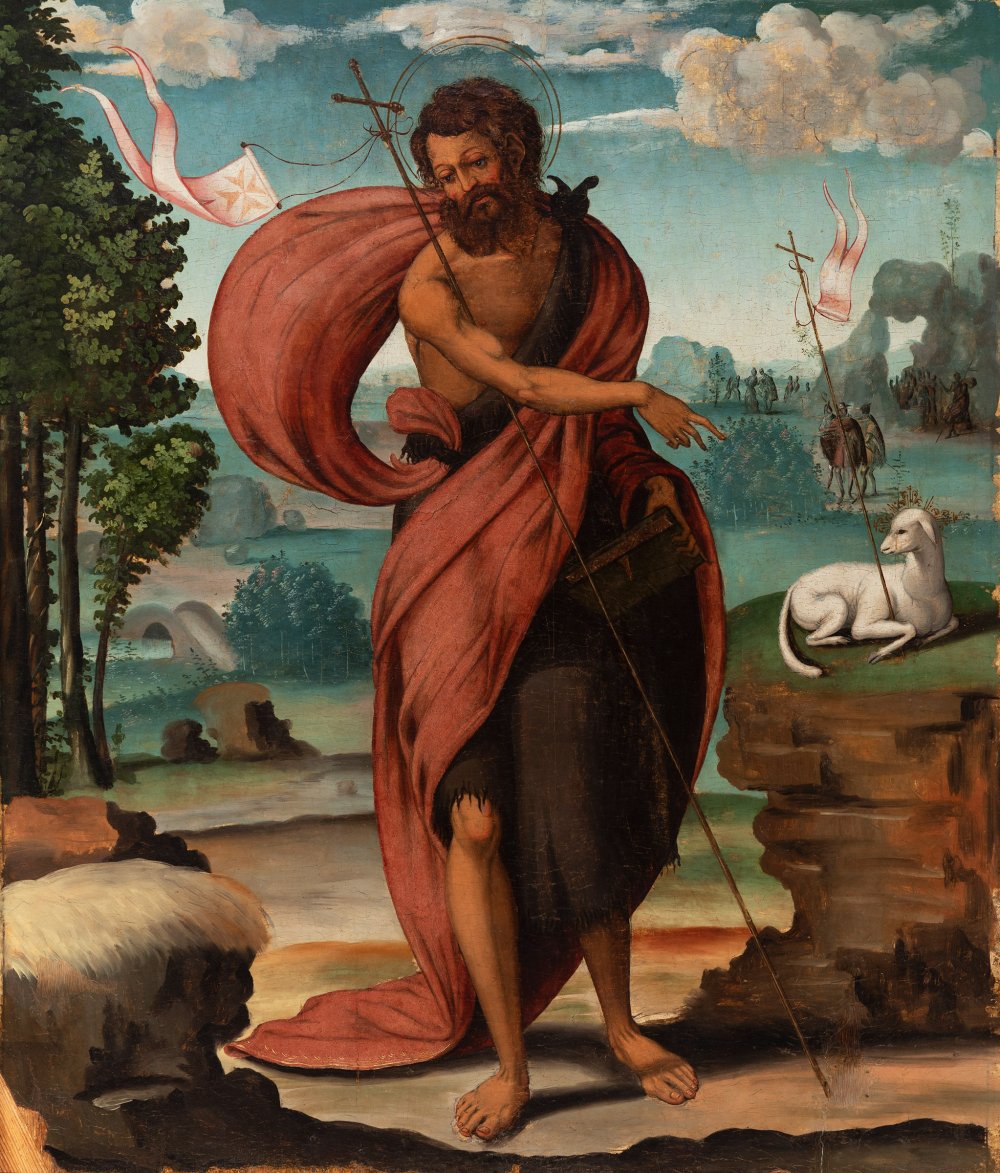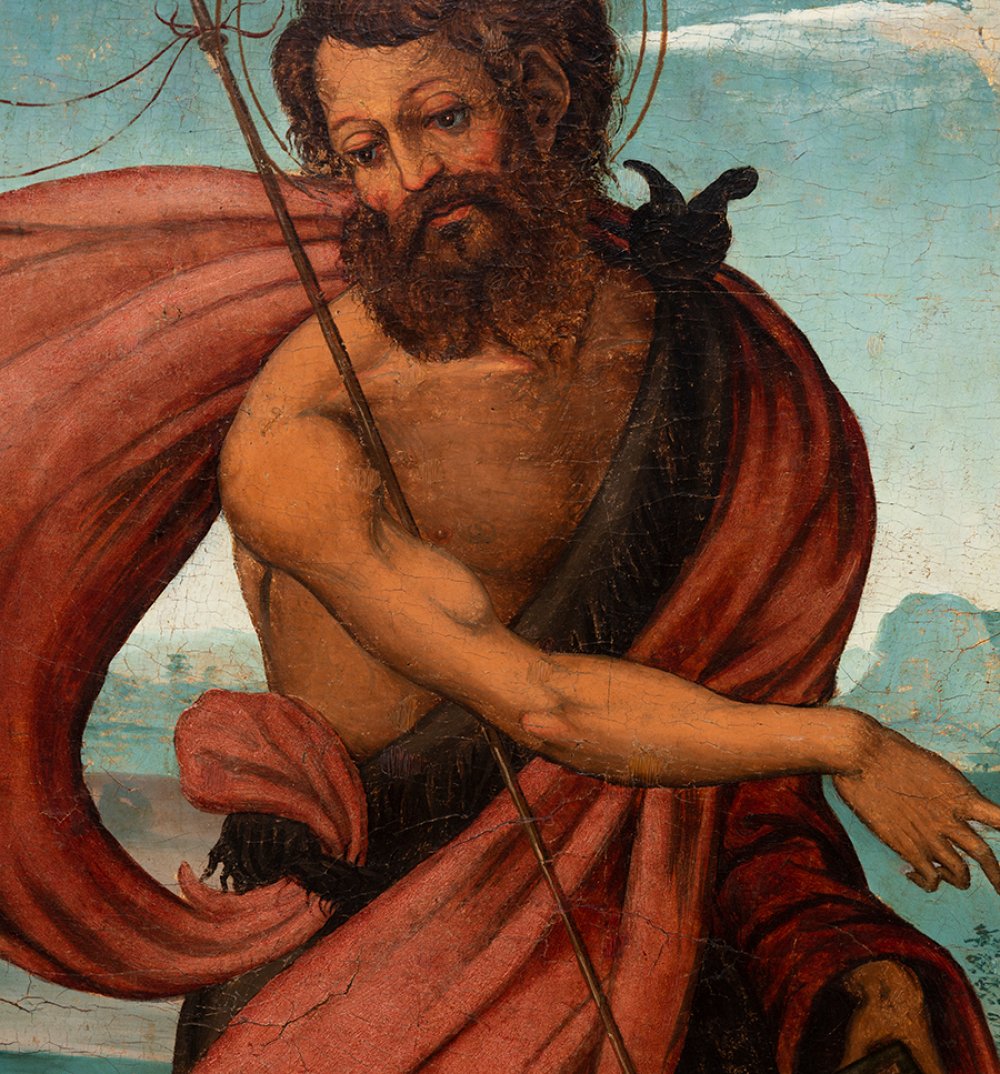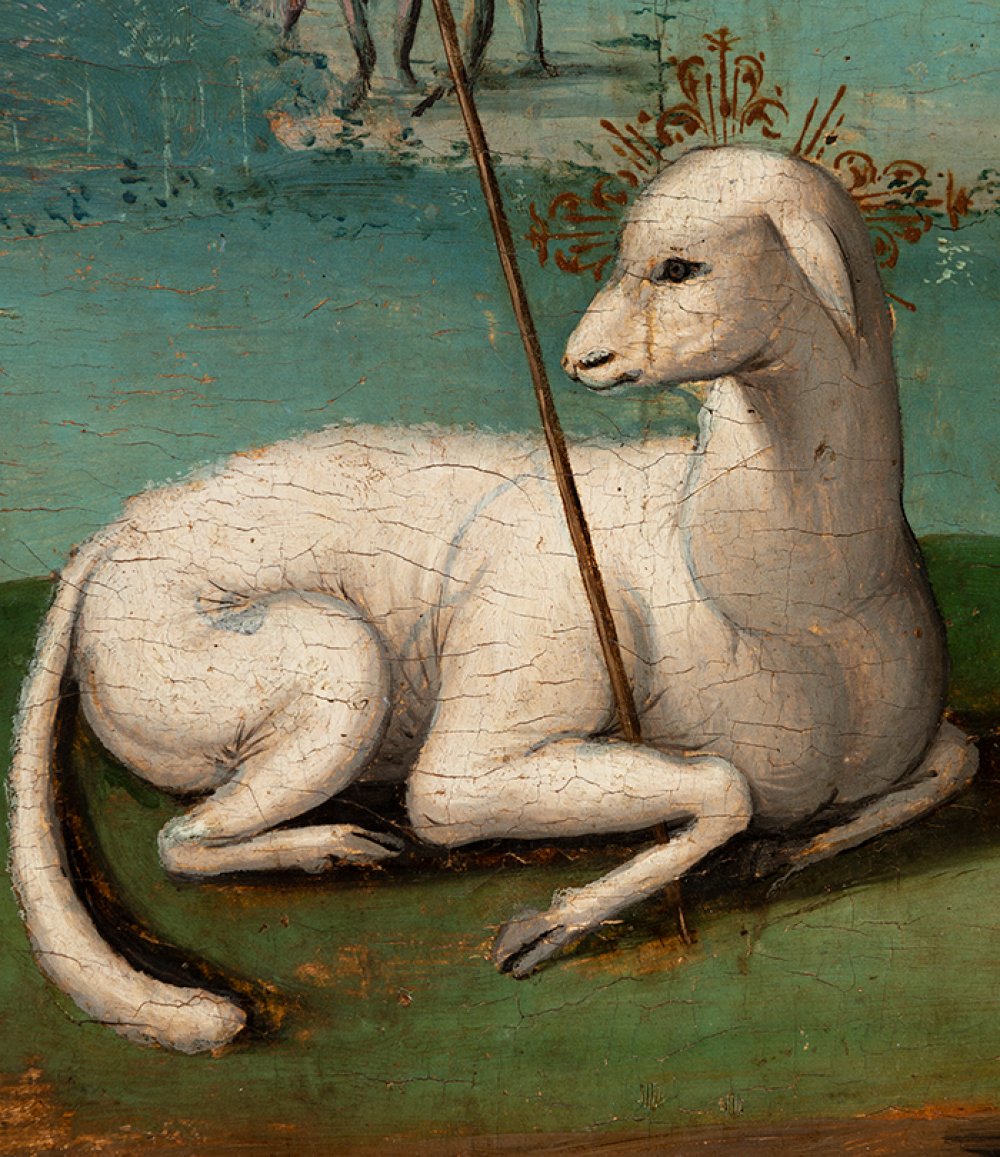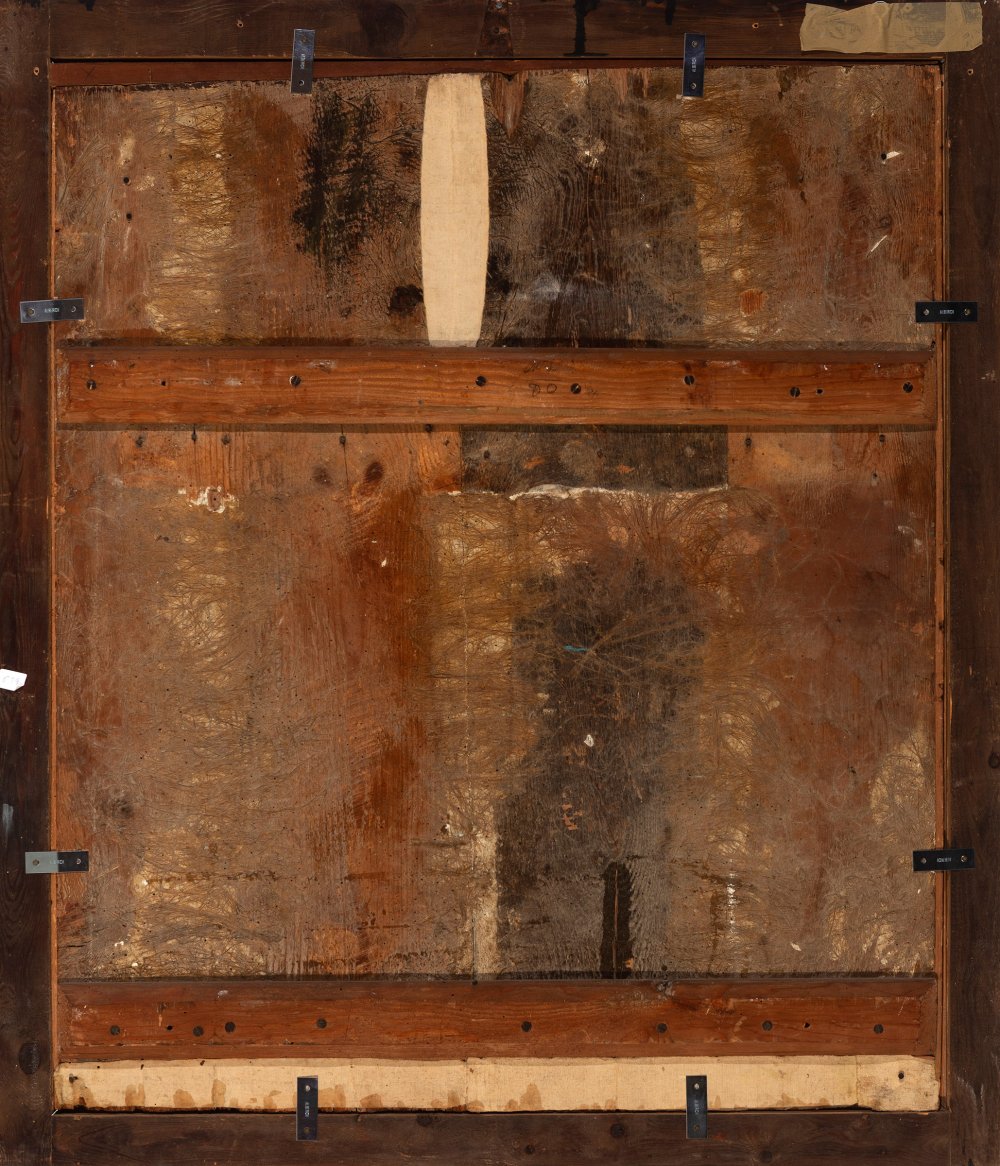48
JUAN DE BORGOÑA DE TORO (doc. 1534-1565)."Saint John the Baptist", around 1550-1565.Oil painting
"Saint John the Baptist", around 1550-1565.
Oil painting on panel.
Attached is a report by Alberto Velasco.
The frame has slight faults.
Measurements: 99 x 86.5 cm; 113 x 97 cm (frame).
In the words of Alberto Velasco in his report "We are looking at an altarpiece compartment showing a full-length representation of Saint John the Baptist. The saint appears in the centre of the composition with his characteristic attributes. He is barefoot and wears the usual camel skin, knotted above the left shoulder and exposing part of his torso and legs. Above this, he wears a crimson-toned cloak that does not fit the body and which takes on a prominent flight to the right of the saint, in the classical manner, simulating the effect caused by the wind. The central part of the cloak is open and reveals the left leg, while at waist level it is tied to the camel skin. The opening of the cloak allows the painter to play with light and shadow with his left hand, and resting it on his left thigh, he holds a book with gilt cuts and clasps and covers imitating green velvet, while with his right hand he points to the Agnus Dei or mystical lamb resting on a mound to the viewer's right". He continues: "The painter has paid particular attention to the depiction of detail, as can be seen in the shading of the nasal septum, the flesh tones and the delicacy of the eyebrows. On the face, we can even see how part of the underdrawing emerges. A delicate nimbus, traced with two fine circles made with pigment imitating gold, frames the back of the head. The Flemish-style landscape is developed from a solvent and vaporous gradation of tones, revealing the painter's desire to create an atmospheric effect.
According to Velasco himself, "The author of this work is a master fully in line with the assumptions of Renaissance painting in Castile. The broad flounce of the cloak reveals a certain mannerism that can also be deduced from his chromatic palette, with pastel tones such as those of the cloak or the blues of the background, or the gradations he applies to the landscape and the ground. His mastery of drawing can be seen in the figuration. The characteristics of the work allow it to be placed in a very specific context, namely that of the dissemination in Castile of the art of Juan de Borgoña, the great Renaissance master active in Toledo. The author of the panel is clearly indebted to that painter, to whom we owe figures of similar anatomical rotundity set in landscapes of clear northern origin, such as a Saint John the Evangelist from the convent of Santo Domingo el Real in Toledo". He continues, "In any case, the clearest parallels are to be found in works by Juan de Borgoña de Toro, a painter who should not be confused with the aforementioned Juan de Borgoña who was active in Toledo".
After an exhaustive study, Velasco concludes that "in view of Juan de Borgoña de Toro's career, it is very likely that the present panel corresponds to the final period of his career, once his permanent collaboration with Lorenzo de Ávila had come to an end. This leads us to place it between 1550 and 1565, bearing in mind that Burgundy died between 1550 and 1565. The work, however, clearly refers to the models of Lorenzo de Ávila that Burgundy knew during the many years he collaborated with him, as can be seen in the position of the saint and his facial characterisation, the shading, the configuration of the landscape and the clouds, and the contrasting colour palette. To all this Juan de Borgoña adds some aspects that are not so evident in Lorenzo de Ávila's production, such as the muscular anatomical treatment of the saint, the expressionism of his face or the cloak billowing in the wind, aspects with a mannerist profile that relate his work to the ascendant of Alonso Berruguete in some artists of that environment".
"Saint John the Baptist", around 1550-1565.
Oil painting on panel.
Attached is a report by Alberto Velasco.
The frame has slight faults.
Measurements: 99 x 86.5 cm; 113 x 97 cm (frame).
In the words of Alberto Velasco in his report "We are looking at an altarpiece compartment showing a full-length representation of Saint John the Baptist. The saint appears in the centre of the composition with his characteristic attributes. He is barefoot and wears the usual camel skin, knotted above the left shoulder and exposing part of his torso and legs. Above this, he wears a crimson-toned cloak that does not fit the body and which takes on a prominent flight to the right of the saint, in the classical manner, simulating the effect caused by the wind. The central part of the cloak is open and reveals the left leg, while at waist level it is tied to the camel skin. The opening of the cloak allows the painter to play with light and shadow with his left hand, and resting it on his left thigh, he holds a book with gilt cuts and clasps and covers imitating green velvet, while with his right hand he points to the Agnus Dei or mystical lamb resting on a mound to the viewer's right". He continues: "The painter has paid particular attention to the depiction of detail, as can be seen in the shading of the nasal septum, the flesh tones and the delicacy of the eyebrows. On the face, we can even see how part of the underdrawing emerges. A delicate nimbus, traced with two fine circles made with pigment imitating gold, frames the back of the head. The Flemish-style landscape is developed from a solvent and vaporous gradation of tones, revealing the painter's desire to create an atmospheric effect.
According to Velasco himself, "The author of this work is a master fully in line with the assumptions of Renaissance painting in Castile. The broad flounce of the cloak reveals a certain mannerism that can also be deduced from his chromatic palette, with pastel tones such as those of the cloak or the blues of the background, or the gradations he applies to the landscape and the ground. His mastery of drawing can be seen in the figuration. The characteristics of the work allow it to be placed in a very specific context, namely that of the dissemination in Castile of the art of Juan de Borgoña, the great Renaissance master active in Toledo. The author of the panel is clearly indebted to that painter, to whom we owe figures of similar anatomical rotundity set in landscapes of clear northern origin, such as a Saint John the Evangelist from the convent of Santo Domingo el Real in Toledo". He continues, "In any case, the clearest parallels are to be found in works by Juan de Borgoña de Toro, a painter who should not be confused with the aforementioned Juan de Borgoña who was active in Toledo".
After an exhaustive study, Velasco concludes that "in view of Juan de Borgoña de Toro's career, it is very likely that the present panel corresponds to the final period of his career, once his permanent collaboration with Lorenzo de Ávila had come to an end. This leads us to place it between 1550 and 1565, bearing in mind that Burgundy died between 1550 and 1565. The work, however, clearly refers to the models of Lorenzo de Ávila that Burgundy knew during the many years he collaborated with him, as can be seen in the position of the saint and his facial characterisation, the shading, the configuration of the landscape and the clouds, and the contrasting colour palette. To all this Juan de Borgoña adds some aspects that are not so evident in Lorenzo de Ávila's production, such as the muscular anatomical treatment of the saint, the expressionism of his face or the cloak billowing in the wind, aspects with a mannerist profile that relate his work to the ascendant of Alonso Berruguete in some artists of that environment".
26th October - Old Masters
Sale Date(s)
Venue Address
General delivery information available from the auctioneer
Setdart offers Worldwide shipping
PICK UP IN ROOM: You can come and pick up your lots in our offices (Barcelona, Madrid or Valencia). At the moment of the withdrawal, you will be able to accept the current conditions of the lot by means of a document that you will sign.
YOU CAN SEND ANOTHER PERSON TO PICK UP: This person must present a signed authorization that you can find in our web page by accessing from BUY AT SETDART- LOGISTICS-DOWNLOAD AUTHORIZATION DOCUMENT. You can also send an e-mail with the requested data in AUTHORIZATION DOCUMENT to admin@setdart.com
Important Information
25% buyer´s premium
21% buyer´s premium at www.setdart.com
Terms & Conditions
The maximum period to pay the lots is 7 working days. You can pay either via bank transfer or with credit card through our platform www.setdart.com (we only accept VISA or Mastercard).
BUYER´S PREMIUM: 22% Hammer price + 21% VAT from the buyer´s premium
If your piece has more than 100 years, our Ministry of Culture requires an export certificate in order for the piece to leave the country. Note that if the piece goes inside the EU, there is no cost for the export certificate. If the piece goes outside the EU, there is a cost for the export certificate. You can find more information in our Ministry of Culture website: https://www.culturaydeporte.gob.es/en/cultura/patrimonio/exportacionimportacion/exportacion/tasas.html
INQUIRIES: admin@setdart.com
Setdart guides you through the entire process, from the time of award to the day you receive your lot. Our logistics team will be happy to manage your transport, and will advise you on the best shipping method with professionals from the sector used to handling works of art and jewelry.
WE OFFER WORLDWIDE DOOR TO DOOR SHIPPING
PICK UP IN ROOM: You can come and pick up your lots in our offices. At the moment of the withdrawal, you will be able to accept the current conditions of the lot by means of a document that you will sign.
YOU CAN SEND ANOTHER PERSON TO PICK UP: This person must present a signed authorization that you can find in our web page by accessing from BUY AT SETDART-LOGISTICS-DOWNLOAD AUTHORIZATION DOCUMENT. You can also send an e-mail with the requested data in AUTHORIZATION DOCUMENT to admin@setdart.com
SETDART IS NOT RESPONSIBLE FOR THE STATE OF THE PARTS ONCE THEY LEAVE OUR FACILITIES. MRW SHIPMENTS: Once the payment is made, your lot will be packed for shipment, the logistics department will send you an e-mail notifying you of the day it leaves our warehouse, changes of address cannot be made after receiving this e-mail.
INSURANCE INCIDENTS: Coverage for the value of the auction up to 3000 ? per shipment, if the value of the auction is higher, Setdart will send you a quote including the additional insurance. The insurance company WILL NOT BE RESPONSIBLE FOR THE SHIPMENT THAT EXCEEDS THAT AMOUNT AND IS NOT FULLY INSURED. MRW INCIDENTS: Maximum notification 48 hours after receipt, after which the insurance company WILL NOT BE RESPONSIBLE AND NO CLAIMS WILL BE ACCEPTED.
E-MAIL LOGISTICS: logistica@setdart.com
PICK UP YOUR MESSAGES: You can send your own messaging, prior notice via e-mail that your shipment is ready, please note 3 or 4 days in advance. This type of shipment is packaged so Setdart will provide you with a quote.
EXPENSES FOR STORAGE: We inform you that if the purchased lot is not picked up within a month, you will be charged 30€ per week per lot. Setdart Online S.L., owner of the web site "setdart.com", "setdart.net" and "setdart.org", acts as a company of Spanish nationality inscribed in the Volume 36955, sheet 182, page B-293056 of the Mercantile Registry, with registered office at Calle Aragó















